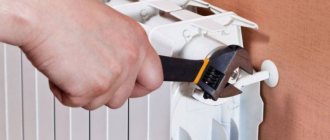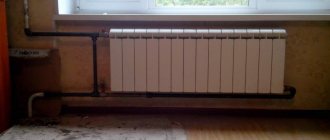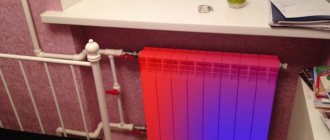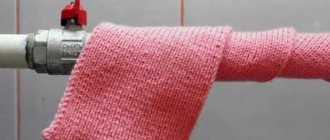In winter, during the heating season, depressurization of the system occurs extremely rarely. Most often this happens during hydraulic tests, when the pressure of the working medium increases. Loose or worn connections begin to leak, sometimes causing cracks to form in pipes or sections. When water starts dripping from a plumbing fixture, this is an alarming signal. The main thing is to know what to do if the heating battery leaks. But many are lost and don’t understand where to call or what measures to take. If you don’t want to flood your neighbors, you need to act consistently and quickly.
Why is the heating battery leaking?
Before figuring out how to fix a radiator leak between sections or in another place, you need to understand the causes of the problems that arise:
- Cast iron radiators are heavy and are mounted on durable hooks. With minimal error, radiators sag under their own weight, and a misalignment of several millimeters causes the formation of air pockets. Corrosion begins in these places - the cast iron becomes thinner and over time a fistula forms. A minor leak appears, which it is advisable to quickly fix.
- In houses with a centralized heating system, water hammer often occurs, which sometimes causes radiators to leak at the joints (especially for bimetallic radiators).
- Cast iron radiators are rough inside, so all kinds of debris and foreign inclusions linger on the surface: pieces of metal, rusty sediment, etc. Gradually, the channels begin to clog, and deterioration in coolant circulation leads to the risk of a breakthrough or leak. This is another reason why batteries, both cast iron and steel, leak.
- Gaskets and nipple threads are the weak points of heating radiators, so leaks can form in these places.
Practice shows that leaks in aluminum, steel and other radiators do not appear suddenly. First, characteristic signs appear: the air temperature in the room decreases, plaque forms on the radiator, and corrosion spots form on the surface.
Do not remain idle when you notice these signs, but decide what to do - the battery is already leaking. If you ignore the situation, an accident may occur. You may also soon find a puddle of water under the radiator, and the humidity level in the room will increase noticeably. You can repair the leak in the heating radiator yourself or contact a professional. An experienced plumber from our company will quickly fix leaks in any radiator: aluminum, steel, bimetallic, cast iron.
Many people are concerned about the question: if the battery is leaking, who should they call? If you live in an apartment with central heating, contact the management company or us. In other cases, you can do without a management organization - it will not help you.
The radiator is leaking. What to do legally
If your heating radiator is leaking, then, of course, the management company, the service company that services your home, will do everything possible to ensure that you repair and repair your radiator yourself. One should not think that the officials and managers of these organizations have not heard of the Resolutions of the Government of the Russian Federation and the State Construction Committee listed in the first part of our note. We heard!
Replacing a heating radiator with your own hands
But they will try to come up with different clauses like: “We serve until the first valve, and the rest is all yours!”
As a rule, if you seriously intend to resolve the issue in court, then the nerves of officials and managers cannot stand it, and they lose ground. But sometimes they can outplay you. For example, your battery tap is leaking. Who should change it? As a rule, such a crane is not listed in the technical documentation (especially if you live in a Khrushchev or Brezhnevka building built in the 60-70s of the last century). This means that you installed it yourself, and you yourself must take care of it.
The cause of a leaking faucet may be its destruction.
Now service organizers even draw up an inventory of the property they take for service. And, for example, if you replaced an old cast-iron battery with a newfangled bimetallic one, then the service organization may not take it for service! The battery is really yours! And you probably installed it without the consent of the housing office and the rest of the municipal power vertical!
For information on how to properly replace batteries in an apartment, see the following article.
If you are interested in where you can buy a tap for a heating battery, read the article at: https://remontspravka.com/gde-kupit-ekran-dlya-batarei/
The replacement of batteries in an apartment building must be coordinated in the same way as any other alteration of common property: the installation of additional doors in the main walls, the removal of heating to a glazed loggia, etc. That is, draw up a plan, order a technical project from a certified organization, etc.
In general, it won't be a hassle. Therefore, in Russia in general and in Moscow in particular, if a heating radiator leaks, “what should I do?” citizens don’t ask, but go to the store, buy a new radiator with their own money, secretly give the plumber a hand so that he installs this radiator, and themselves make sure that it doesn’t leak.
Electric oil cooler can also leak
Since we are talking about such a sensitive topic, it would be a sin not to answer the question: “What to do if the oil radiator leaks?”
We are, of course, talking about an electric interior heater. and not about a car radiator cooling.
Again: there are two options.
1. The radiator flows at the connection point of the heating element. The reason is that the gasket has failed. You can change it, but try to find the one you need! Even in branded service centers this is not always the case.
The second option is to seal the leak with a high-temperature oil-resistant sealant. These are sold in spare parts stores and are used to repair car radiators.
Oil cooler repair
2. The radiator flows “along the ribs” of the convector. The reason is depressurization of the device. Usually the result of a fall. We have to throw it away. You can’t fix it at home, but in a workshop they will charge so much that it will be cheaper to buy a new radiator.
FAQ
Homeowners have the same questions about how to solve such problems.
The following are often of interest:
- where to go if the battery leaks;
- what to do if it is not possible to turn off the water;
- who is to blame if the neighbors are flooded?
Where to go if the heating battery is leaking?
It makes sense for owners of apartments in multi-storey buildings to call a plumber by contacting the housing and communal services service, HOA or management company. Emergency telephone numbers should be posted in entrances. There is an option to call an employee of a private company that provides such services. In a private home you will have to deal with the problem yourself.
How to eliminate a leaking heating battery without shutting off the water?
If the cause of the leak is a crack in the pipe, it can be wrapped in rubber and tightened from above with any clamp or wire. If it is a small sink, then you need to take a metal screw with a rubber washer and screw it in with a screwdriver. These measures are only effective at low pressure in the circuit. After the manipulation, you need to turn on the pump and make sure that the repaired area can withstand the water pressure in the system.
When radiators leak in an inaccessible place and the leak is small, you should add mustard to the expansion tank. Place a container under the dripping unit and increase the temperature of the water in the system. Mustard powder, like a liquid sealant, reaches the leak and closes it. There are ready-made liquid sealants on sale just for such cases. Add them to the system, and all minor leaks will stop bothering you.
Who is to blame if a heating pipe bursts and floods the neighbors?
The owner of the apartment panics when hot water breaks out and rushes out in all directions. By the time you reach the tap, the entire floor will flood. And the floor of the room serves as a ceiling for the neighbors below. You can localize a leak by throwing any thick rag over the break site. The water will flow down it, where you place the basin. This will give time to turn off the water and turn off the pump, if there is one.
When your apartment has centralized heating, the algorithm of actions is different.
A breakdown in the heating system can happen at any time of the year. The management company must conduct technical tests of pipes before the heating season. To do this, they are tested by applying high pressure. Residents should be warned about this. If a breakthrough occurred as a result of such a procedure, then the actions are as follows:
- If you are at home at the time of the breakthrough, then turn off the water.
- Call the management company by phone and report the incident.
- Capture on photo or video:
- location of damage (breakthrough);
- consequences of flooding: damaged property in your apartment;
- damaged property and belongings of neighbors.
- Achieve the drawing up of an act.
Sometimes citizens think that it is better to install air conditioners and turn them on for heating than to compensate their neighbors for damage. Air conditioners are not designed to operate in temperatures below -4°C. The condensate in the drain pipe freezes, the external unit suffers, and the device may fail. It is best, if possible, to install individual heating. In this case, it is necessary to replace metal pipes with plastic ones and install aluminum radiators.
First aid for a leaking radiator
This article will be useful not only for those who are faced with the question of how to fix a leaking heating radiator. Since the situation is everyday, and plumbing equipment tends to wear out (especially in old houses), everyone needs to know the strategy of action in case of detection of a leak. The battery is leaking, what should I do? – the answer to this question will be exhaustive.
It is important to understand that leaks vary in complexity and location, and in the event of a real hot flood, you should immediately call the emergency service by calling the control room
Before you begin to clean up the accident, you need to know about safety precautions
Health is more important than property
When the battery leaks, what to do is just as important to know as what not to do!
- If hot water is gushing in all directions, forget about your property and, first of all, take safety measures to protect yourself and your loved ones from thermal burns. Repairs, things, equipment are not the most important thing.
- Throw a blanket, preferably a cotton one, over the leak. Or something that can absorb water for a while and prevent it from splashing.
- Do not get carried away with safety nets in the form of buckets, basins and rags - this temporary measure may cease to be effective at any time, especially if emergency flooding begins. The amount of water in a cast iron battery is quite large.
- Do not rely on the myth that a leak can go away on its own, become stuck and become overgrown with rust.
- A leak in a heating battery discovered before going to bed or before work, even if it is minimal, should under no circumstances be ignored. The average person is unlikely to be able to visually assess the scale of the accident and destruction of the mechanism: the leak may not expand for weeks, or it may turn into a flood in a couple of hours
- Try to shut off the coolant supply to the batteries. The valve for this procedure is usually located in the basement of the house.
- In the event of emergency flooding, after shutting off the water in the riser, nothing better can be thought of than draining the water from the batteries. In this case, repairing the breakdown will be quick and safe.
Option to collect water
Pipe connection is leaking
Leaks at pipe joints can be eliminated using the same homemade or factory-made clamps. If there is a difference in diameter, you can first wind the rubber band and then make or put on a clamp.
If the connection is threaded and drips from under the winding, you can pour alcohol onto the tow and then spread it with BF glue. It is alcohol soluble. Once on the alcohol-contained tow, it liquefies and can flow into the joint. Then, when the alcohol evaporates, the glue dries, and the “drops” stop. But this method only works if you have “drops” and not a “fountain”. And one more thing: such a processed connection is then very difficult to disassemble.
If it is possible to stop the system or disconnect the radiator (if there is a leak at the junction with it), it is better to repack the threaded connection. To do this, carefully and slowly unscrew the nut (lock nut). It needs to be turned away and then wrapped. Don’t make significant efforts - there is a high chance of breaking it, and then you will definitely have to stop the system and redo everything. After tightening the nut, remove all the tow or fum tape, remove any remaining sealant, and in general, thoroughly clean the threads. Wipe it until clean, you can treat it with a degreaser (acetone or pure gasoline).
If it leaks under the locknut, it can be repacked
Please note that there is no excess tow - just a little, and paste on top. Take the winding and paste (sealant), wind the flax and coat everything with the paste. Now you can twist
First with your hand, then with a key. But here you also need to work carefully: it’s very easy to break the thread. Therefore, hold the key not by the edge, but in the middle - it’s easier to calculate the effort. Don’t overdo it with the amount of tow either. If cast iron, in principle, does not matter how much winding you wind, then aluminum and bimetallic, as well as steel, can crack from a large amount. A microcrack first appears in the collector, into which water leaks. The metal corrodes, the paint swells, a section (or the entire radiator) is damaged
Now you can twist it. First with your hand, then with a key. But here you also need to work carefully: it’s very easy to break the thread. Therefore, hold the key not by the edge, but in the middle - it’s easier to calculate the effort. Don’t overdo it with the amount of tow either. If cast iron, in principle, does not matter how much winding you wind, then aluminum and bimetallic, as well as steel, can crack from a large amount. A microcrack first appears in the collector, into which water leaks. The metal corrodes, the paint swells, a section (or the entire radiator) is damaged
Take the winding and paste (sealant), wind the flax and coat everything with the paste. Now you can twist it. First with your hand, then with a key. But here you also need to work carefully: it’s very easy to break the thread. Therefore, hold the key not by the edge, but in the middle - it’s easier to calculate the effort. Don’t overdo it with the amount of tow either. If cast iron, in principle, does not matter how much winding you wind, then aluminum and bimetallic, as well as steel, can crack from a large amount. A microcrack first appears in the collector, into which water leaks. The metal corrodes, the paint swells, a section (or the entire radiator) is damaged.
But this is all in cases where the threaded connection is leaking. If a fitting under a press (metal-plastic pipes) has leaked, you can try to simply tighten it. In the case of copper pipes, only soldering will work. If there is a leak at the junction of polypropylene pipes, there is also only one option - cut out the damaged piece and weld a new one.
It doesn't matter what you use. The result is important
Possibility of repairs
If the cooling radiator leaks with a small crack, you can fix the problem yourself. But if a leak occurs at the junction of the plastic pipe and the radiator itself, then such a malfunction cannot be eliminated. Temporarily, if it is impossible to quickly purchase a new radiator, you can use sealant or epoxy glue.
If there are several or one small crack through which antifreeze flows a few drops at a time, then you can quickly achieve the result with a special sealant. It should be poured into the cooling system. The components are substances that heal small cracks and create a tight seal of the radiator housing. After this, you can drive a car, since it takes some time for the sealant to take effect, after which the leak should stop.
Many car owners do not know what to do if the radiator leaks due to corrosion. In this case, sealants are useless, and the radiator can only be repaired by soldering. This is a rather complex process, and can only be done with extensive experience and special equipment. It is also difficult to repair a radiator with mechanical damage. Sometimes argon welding is used for this.
When doing independent work with a radiator for the first time, you need to prepare to redo the work. It is impossible to immediately detect all the cracks on the radiator by looking at it. This can only be seen when installing it and starting the engine. If after 30 minutes of idling no leakage appears, this means that a good result has been achieved. If a leak appears, work should be started from the very beginning.
Types of leaks
Each connection of parts represents a potential threat of possible depressurization.
Please note: a leak is the release of coolant from the heating system due to damage in one of the elements.
Depending on the type of connecting elements used, there are several types of leaks that are typical for heating batteries:
- leakage resulting from a crack in the battery section;
- damage to the tightness of the main pipes that connect the main riser to the batteries;
- leaks in the intersection connections of the heating radiator;
- depressurization of the connection between the radiator and pipes.
Each type of leak needs to be repaired using certain repair methods.
Between battery sections
If a leak appears between the sections, this means the rubber or paronite gasket has become inelastic and/or the coolant has corroded it. There is another possible reason - corrosion has “eaten” the nipple. In any case, for major repairs it is necessary to disassemble the heating device into sections and replace the damaged part.
If the heating does not work or the radiator can be turned off without stopping the system, it is removed, disassembled, old gaskets are removed, new ones are installed and reassembled. Read how to assemble/disassemble the battery here.
If not, you can temporarily seal or seal the leak. It is very difficult to perform this trick with aluminum or bimetallic radiators - the distance between the sections is very small. But with cast iron type MS-140 it’s possible to do this.
First you need to clean the leak site
First you need to clean the place where the coolant is leaking: remove everything to the metal. Where there is access, remove with a spatula or a brush with metal bristles. Where there is no access, we take a metal cable and peel it off with its help. We pass it around the collector in the place where processing is required, and pull it by one end or the other. After a while, everything that can fly away flies away.
On the cleaned surface we will apply the same composition as when insulating pipes: epoxy resin and metal powder or “cold welding”. Only the strips of fabric needed are narrower and longer. Wipe it dry and clean, apply the compound, wrap it in cloth, apply more glue, another turn. So 4-5 turns. Do not smear the top one. For reliability, you can tighten it at the top with a clamp.
If you have ready-made iron putty, you can apply it (or make it). Then 3-4 turns of fabric coated with the composition will be enough. The simplest recipe that is suitable for eliminating a leak in a cast iron battery: add drying oil to red lead and grind to make a paste. And apply it between sections. If you have white lead, mix it with red lead and add drying oil. The consistency is the same: mush.
In any case, such radiator repair is only a temporary measure. After the end of the heating season, repacking is necessary.
The main types of breakdowns of heating batteries
Metal corrosion is the most common cause of leaks
In order to competently and reliably eliminate a leak in a pipe or radiator, you need to know and have a good understanding of the nature of the occurrence of such a phenomenon.
The formation of cracks and holes occurs for the following reasons:
- metal corrosion that occurs when black iron comes into contact with oxygen present in air and water;
- use of low-quality material when assembling the structure;
- water hammer, the consequence of which is the appearance of cracks;
- wear of gaskets installed at joints and in places of threaded connections;
- mechanical damage associated with a strong blow from a hard object during repair or movement of household appliances;
- violation of assembly and welding technology during installation.
In places of threaded connections, leaks are caused by leaky rubber gaskets
All these prerequisites lead to breakdowns of the following nature:
- Gaps in the radiator. Such malfunctions are the most unpleasant, as they appear in difficult, sometimes inaccessible places. Sometimes several ribs or the entire product are covered with water. Most often, the heating battery leaks at the joints of the sections. This occurs due to drying out of the gasket or increased pressure in the pipeline. Less often, holes form in the housing. The reason for this lies in a manufacturing defect, which is impossible to identify at the installation stage, since the defect manifests itself over time.
- Through cracks in pipes. They are the result of poor quality welding or manufacturing defects. Most often they occur at the seams of piping pipes, at their junctions with each other and with the riser. Often the problem arises due to electrolytic corrosion when property owners short circuit the heating circuit to zero or ground from household appliances.
- Freezing or overheating of the pipeline. A common problem for country houses and dachas, sometimes occurring in the urban sector. Expanding when freezing, water tears apart the metal, leaving cracks of varying widths and lengths. They may not be immediately noticeable, but when the water thaws, the defect will immediately appear. When iron overheats, thermal expansion occurs. If communications have nowhere to move, they collapse, burst or crack in weak spots.
- Cracks in the joints of batteries and pipes. Leakage occurs due to a leak in the connection. The most common cause is metal corrosion as a result of the welding joint. Sometimes a hole is formed due to the inexperience or negligence of the craftsman, who left a thin layer of metal on the seams. The problem of leakage may be due to the wrong choice of installation location for load-bearing anchors, when mechanical stresses arise due to misalignment. Often a pipe leaks after people have stood on it or suspended heavy objects.
Temporary solution
So, if water runs in a thin stream from any place in your radiator, and you do not have the opportunity to stop the flow of coolant, then you can try to block the damaged area in such a way as to prevent further troubles. To do this, you will need something rubber: for example, an old rubber boot, an inner tube from a bicycle or car wheel, a household or medical glove - in general, anything as long as it is made of rubber.
The algorithm of actions is simple.
- Cut the rubber product into strips. The longer they are, the better. The width of each strip should be such that the leak can be completely covered.
- Now you need to wrap the damaged area with the resulting strips. Start the process near the place where the water is flowing, gradually moving towards it. The turns should overlap each other slightly. It is necessary to wind the rubber as tightly as possible - the tighter the fit of the strips, the more reliable the effect will be.
- After the winding is done, it needs to be fixed. To do this, make a tie using a fabric tourniquet - it must be placed over the leaking area. Instead of fabric, you can use strong wire, but it must be wound in the same way as rubber, in turns across the entire width of the original winding. A car clamp is also suitable - this is generally quite a useful thing that can be useful on the farm many times, so it is recommended to purchase more of them for the future. Another option for securing the patch is a strip of tin. It can be tightened over the rubber using bolts.
Of course, such a solution is only temporary. Ideally, after eliminating the leak in this way, it is still advisable to call the emergency service so as not to risk it. But in many cases, such a rubber patch helps you survive until the end of the heating season, and then you can safely do more general repairs or replace the battery.
You can make your life even easier if you purchase special plumbing clamps to eliminate such troubles. They are designed specifically for pipe repair. Such a clamp is a metal product with rubber attached to the inner wall. That is, in essence, this is the same patch described above, but its application is much more convenient - fixing the leak will take about a minute.
If this solution does not work, and the coolant still continues to leak from under the patch, then you still need to either call an emergency team, or, if possible, stop the heating system yourself and begin serious repairs. There are several ways to eliminate a leak. The simplest of them is gluing.
This is interesting: How to choose bathroom furniture
Causes of cold radiators
Especially if we are talking about a city apartment, the provision of heat in which should be handled by the housing and communal services service or another authorized body that checks the preparedness of the entire system for the heating season. Well, in the case of a private house, solving problems falls on your shoulders. If you wish, you can contact the Eurolux Group company; this company will carry out all the work quickly and inexpensively.
And here it is important to understand the main causes and individual problems that will need to be eliminated in order for the batteries to give off the maximum amount of heat. Advice: if you call a plumber to your home, check whether only one battery is cold, or whether a similar problem has occurred in the entire apartment, riser or entrance
To do this, interview your neighbors so that it is easier for a specialist to determine the possible cause of the problem and repair the system faster.
Advice: if you call a plumber to your home, check whether only one battery is cold, or whether a similar problem has occurred in the entire apartment, riser or entrance. To do this, interview your neighbors so that it is easier for a specialist to determine the possible cause of the problem and repair the system faster.
- presence of air pockets in the heating system;
- technical blockage of a single battery;
- incorrect connection of each of the elements and the entire system as a whole.
These criteria can affect the performance of both the individual battery and the overall system. Only after these problems have been eliminated will it be possible to talk about the full functional operation of the heating system in each room.
Let's consider each reason separately.
Air jams
Traffic jams can occur due to the appearance of excess air during radiator operation. At the same time, if we are talking about a city house, then, as a rule, the upper floors of high-rise buildings suffer.
But this problem can be easily fixed. To do this, in modern batteries special valves are installed in the upper part, which allow the accumulated air to be removed, restoring the operation of the system.
It is important to know: all these procedures must be performed without high pressure and hot water or reagent in the system, in order to avoid burns.
Heating system clogged
To perform flushing efficiently and quickly, follow these recommendations:
- move furniture aside, remove curtains, cover the floor with cellophane or cloth to avoid damage;
- shut off the coolant supply using the shut-off valve. If it is not installed, remove the battery, unscrew it and pour the liquid into a basin;
- to clean the radiator, it must be moved to a bathtub, at the bottom of which it is recommended to place a wooden floor;
- Using a wrench, unscrew the end caps and allow the dirty liquid to flow out of the battery into the bath;
- pour water under pressure from a hose into the battery;
- If a crystalline blockage has formed, it should be cleaned using a special reagent. Through the use of a chemical formula and high-quality pressure in the system, it is possible to remove existing problem areas of scale and corrosion and obtain warm and fully functioning batteries again. You can also use a 70% solution of vinegar and water;
- pour the reagent or vinegar solution into the battery, close the seals and let it brew for 2 hours;
- Rinse the battery inside and outside under high pressure water, wipe the battery dry and install it on the bracket.
Sometimes such actions do not help and you have to buy a new battery.
Connection errors
This does not allow the battery to gain maximum heat, and the upper areas may remain cold. In this case, it is necessary to reinstall the connection elements and release heat through the upper section of the supply pipes and connections.
Actions in case of leakage
When urgent measures do not give a positive result, you need to drain the water from the system and make high-quality repairs to the damaged area.
For this:
- turn off the tap on the riser, warning your neighbors if it is a common valve;
- drain the water from the system.
Knot near the riser
One of the common damages is at the junction of the riser and the pipe. Leakage in this area may occur due to poor sealing of the joint. It is possible that when attaching the pipe, they did not put enough windings on the thread or did not tighten the lock nut.
The connection must be disassembled and re-twisted. Use tape or sealing thread to wind the FUM. It is advisable to replace the locknut. If the weld seam is leaking, then the water from the riser must be drained and the seam made again. To do this, you need to hire a welder.
Radiator sections
Radiator sections are pulled together. There are rubber gaskets at their junction points. Over time, the tie may loosen or the gaskets may become unusable. Water makes its way at the junctions of the sections. First, use adjustable wrenches to tighten the connection without removing the radiator.
If this does not help, then remove the faulty battery. Shut off the water supply, drain the water from the system and unscrew the radiator. Disassemble into elements, install new gaskets. Clean the sections from slag. Reassemble and install.
Battery input
Warm water flowed where the pipe enters the battery. This is a threaded connection consisting of a drive, a coupling and a lock nut. These elements are made separately and sometimes not from high-quality metal. In addition, if the battery is cast iron and poorly secured to the brackets, it creates pressure that deforms the joint over time.
This unit definitely needs to be replaced. It happens that it is impossible to unscrew rusted parts, then they are heated with a gas burner
This operation is carried out with extreme caution, having prepared fire extinguishing agents and fencing the work area with protective screens made of non-combustible materials.
Battery edge
If a crack forms in an accessible area of the battery fin, it can be temporarily neutralized. There are 2 types of welding of heating batteries: hot and cold.
If the battery registers are metal, then hot welding can help fix the leak. If they are aluminum or cast iron, then you can forget about it. In this case, cold welding will help. This requires a high-temperature, water-resistant plastic mass that reacts chemically with such metals.
The area to be welded must be thoroughly cleaned, degreased and dried. Knead the substance until it is homogeneous, apply a small layer and let it harden. Welding products such as ABRO STEEL or POXIPOL do an excellent job. The range of such adhesives is wide. You can select welding for the material from which the radiator is made.
Faucet or joint
When the source of the leak is a faucet, it must be replaced. If the tap has not been used for a long time, it becomes clogged with deposits and does not fulfill its task. However, if its rotating part is moved out of place, it can also leak. When choosing a new shut-off device, give preference to ball valves made of non-ferrous metal.
Leaks at joints can be eliminated by wrapping the damaged area with a bandage soaked in saline solution. After drying, cover the top with a bandage soaked in a mixture of plaster and cement.
Modern industry offers consumers plate glue for this purpose. You should wrap the finished strip around the leak area. When exposed to air, the polymer hardens and eliminates the problem. When using silicone sealants to eliminate leaks at faucet joints or threaded connections, choose neutral compounds. Acid-based sealant may promote subsequent metal corrosion.
Who is to blame and where to call
If the heating radiator is leaking, then, firstly, you need to take a closer look at where it is leaking from and substitute a basin.
You need to place a container under the leak to collect the coolant.
The second question that a citizen has after he is convinced that his battery is leaking: “Who should I call?”
You need to call the housing office or another service company. Most likely, you will be promised to immediately turn off the defective radiator and will be put on a waiting list for repairs or battery replacement. The fact is that, according to the current legislation, and more specifically, the Decree of the State Construction Committee of the Russian Federation No. 170 “On approval of the rules and norms for the technical operation of the housing stock” dated September 27, 2003 and the Government of the Russian Federation Decree No. 491 dated August 13, 2007. , the house heating system, including radiators, is the common property of the house.
Plumber servicing a heating radiator
Therefore, even if the battery leaks in a privatized apartment, its repair or replacement must be carried out at the expense of the monthly contributions that you pay for the maintenance of your home. Don’t accept any excuses like: “Your apartment, your battery is leaking, who should replace it if not you?” For failure to comply with the above resolutions, housing and communal services managers can be brought to administrative or even criminal liability.
But this is in theory. But in practice, fees are collected, but the plumber who comes from the housing office will turn off not just one radiator from the heat supply (if it is equipped with a tap, then you can turn it off yourself), but your entire apartment. And the queue for battery replacement or repair can last for months. During the heating season, when batteries leak, this option is unlikely to suit you.
Is scheduled maintenance required?
During the off-season period, when the heating is not turned on, it is necessary to carry out maintenance of the heating systems. Periodically drain the water and flush the circuit and boiler with reagents containing corrosion inhibitors. Filled into the system for 40 minutes or more, a special liquid will rid the circuit of toxins, salts, corrosion and other deposits. After cleaning, it is necessary to rinse the system with running water and refill. If minor repairs and leaks were repaired during the heating season, it’s time to replace the damaged elements.
Elimination of fistula
For any breakdown there are a number of reasons accompanying it. A fistula on heating system pipes or on a radiator is no exception. If a small brown spot appears on the elements of the heating network, you should not think that it is paint coming off. In fact, this is the beginning of an often irreversible process, but knowing how to repair a fistula in a cast iron battery, you can stop the destruction and extend its service life. Causes of corrosion:
- Taking into account the frequent increases in the cost of utilities, some craftsmen are cunning and, in order to save energy, connect a neutral cable to the heating circuit. The currents that begin their “journey” through the pipes through the coolant are what cause the formation of corrosion. You can identify a dishonest neighbor if there are several fistulas and they appear with a certain regularity. Calling the appropriate service to identify the intruder and repairing cast iron batteries yourself will help save the situation.
- Too much acidity of water can harm even corrosion-tolerant cast iron.
- The batteries have expired or deposits on the battery walls have damaged the metal. In this case, even a small fistula or crack under the influence of water pressure can cause the battery to burst and a stream of hot water to flow from it.
Any of the options requires urgent intervention. If the cast iron battery leaks only slightly, then you can do without disconnecting the circuit and dismantling it. A clamp can save the situation. If the water only drips, then a one-sided clamp will do, but if it runs in a thin string, then it is better not to risk it and use a double-sided clamp.
In the event that the coolant ruptures the place where the fistula was located, the question immediately arises whether it is possible to weld a cast-iron battery. As a rule, cold welding becomes an emergency solution, but even if it has restored the tightness, it is necessary to call specialists from the heating network to check the condition of the heating system.
The most common problems and their symptoms
Although cast iron perfectly tolerates the imperfections of the central heating coolant, and the radiators made from it have wide enough channels so that debris does not accumulate in them, problems can arise even with them. And this despite the fact that there is no wear to this metal. The following factors may be to blame for a cast iron battery bursting or a fistula appearing in its walls:
- Everyone knows the heavy weight of radiators made of this metal. If during installation of the structure, insufficiently strong brackets were used, or there were not enough of them, over time it may sag under its own weight and tilt. Even a slight deviation of just a couple of millimeters will reduce the efficiency of the device, and if the distortion is not corrected, then after a few years corrosion will appear in the place where the coolant is missing. At first it will look like a small brown spot, which will grow with each heating season until a fistula forms in its place.
- The reputation of “long-living” is characteristic of both old and new models of cast iron radiators, but provided that they are installed in the contour of an apartment building no higher than six floors. If the heating network is reliable and does not suffer from strong water hammer, then they can be installed in nine-story buildings. Otherwise, under strong water pressure, the cast iron battery may leak at the joints of the sections. In the event that a cast iron battery leaks during the heating season, you need to know in advance how to repair it. Today there are a lot of sealants that will help the device “hold out” until warm days.
- The internal structure of domestic batteries is such that the cast iron from which they are made has roughness that is completely absent in imported analogues. That is why a lot of debris is deposited on the walls over time, which fills the water in the heating network. Suspensions, particles of rust and metals, all settle and make the wide channel so narrow that it is no longer able to easily pass coolant under high pressure. In this case, the structure may burst anywhere, and then you will have to urgently decide how to eliminate the leak in the cast iron battery.
- Gaskets and nipple threads are the weak “link” of heating devices. If cast iron does not have a statute of limitations, then the same cannot be said about the parts that make up the battery. In order not to lead the situation to the point where repair of the cast iron battery is required, the connections must be checked after each heating season and the gaskets on them must be periodically changed.
As practice shows, most often it becomes known that something is wrong with the heating system when repair of cast iron radiators is already required. To find out about a problem in advance, you need to listen for “help signals” that indicate the presence of defects.
Construction of cast iron radiators
This type of heating device consists of sections.
Models of the old type, even today, are produced in the form of “accordions”, while the new generation has a flat outer panel, which provides better heating of its entire area. When operating, these devices use two types of heat transfer:
- Radiation, or as professionals call it, radiation accounts for up to 25-30% of heat. It not only heats the air, but is transferred to nearby objects, providing better heating of the room.
- Convection produced by the heating battery ensures constant movement of air masses around the room and accounts for about 75% of the heat transfer.
The structure of the cast iron battery, despite all the external changes, remained the same. It consists of sections equipped with:
- plugs;
- locking devices;
- traffic jams;
- shank and thermostat;
- locknuts;
- nipples and gaskets.
No matter how strong cast iron is, even it has its limits. As a rule, the service life of cast iron radiators is 25-30 years, and with proper care and optimal operating conditions they can operate without interruption for 50 to 100 years.
The same cannot be said for the parts that hold the sections together, such as spacers. With frequent water hammer, they can “sway” or crack over time. In this case, a leak appears between the sections of the cast iron battery, which, if not eliminated in time, can cause a serious accident and a threat to human health and life.
To avoid this, you need to check the condition of cast iron radiators after the end of the heating season. In this case, you can detect completely different problems in the heating system.
Read other useful information about cast iron batteries on our website:
Heating system adjustment
After filling the system, you need to go through all the radiators and bleed air through the Mayevsky taps: open the Mayevsky tap, first the air comes out, then the tap “spits” air with water... when only water flows, it means the radiator is filled with water, close the Mayevsky tap. And so on for all radiators.
Most likely, the pressure will drop after manipulating the radiators, so we re-charge the system to operating pressure. If there is a second floor, we bleed air from its radiators in the same way. And - we feed the system to operating pressure.
We bleed the air from the circulation pump. The pump has a screw; you need to loosen it with a wide slotted screwdriver. First, air will come out like from radiators, and then water will come out in a thin stream. After this, tighten the screw. Check the pressure and add coolant if necessary.
Let's start the pump.
Important! Before going any further, listen to see if the pump is working. It happens that it does not work because its rotor is soured
Turn off the pump and fix it by: 1) unscrewing the screw in the center of the pump motor; 2) inside, at the end of the rotor, there is a slot, insert a screwdriver into it and turn the rotor; 3) screw the screw into place. Let's turn on the pump again, it simply must now work.
For 10-15 minutes. Moreover, after 1...2 minutes of operation, we unscrew the screw on the pump again, if water flows, everything is in order. When you turn on the pump, you will hear air coming out of the air vents again, this is also normal. And the pressure will drop, and we will feed the system to the 1.5 atm we need.
While the pump is running, we go through all the Mayevsky taps and check the presence/absence of air in the radiators. And again we feed the system to the required pressure.
Now we believe (for now we only believe) that the system is completely filled with coolant (but we are not too delusional, air can leave the system for up to 3 weeks or even up to a month, especially if there is a water-heated floor; air will leave the warm floors itself through air vents on the manifolds).










